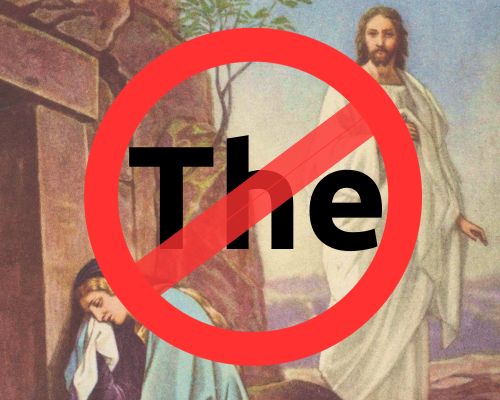
At our Diocesan Synod, we were asked to discuss and vote on removing the word “The” from “The Season of Easter”. This is in a Statute (#766) from General Synod Te Hinota Whanui (GSTHW) which is doing the debating rounds of all diocesan synods and hui amorangi and then will be discussed again at GSTWH for a change to our formularies (our Church’s agreed doctrine and practice).
People would be hard pressed to disagree that currently our Church’s formation, training, and study around worship, liturgical life, and communal spirituality is at its all time weakest. In this context, while previously there was already a strong stream of people who disdained Anglican liturgy, discussions such as this further bolster the misunderstanding that passion about our liturgy is obsessed with nitpicking about inconsequential, petty, and frivolous rules, terms, words, and practices.
It seems that our ageing Church is suffering from Institutional Dementia. I was present at the meeting of General Synod that produced the 1989 A New Zealand Prayer Book He Karakia Mihinare o Aotearoa (NZPB), rightly, via the “twice round” formularies process. That same process was, rightly, used for every revision up to and including the wonderful 2005 revision. But then, in 2020, a book was published with the same title, but a lot of it has not gone through this “twice round” formularies process. Had our Church forgotten how to revise our Prayer Book?
But amnesia can have moments of clarity. At our diocesan synod, we were presented with three GSTHW Statutes to assent to (763, 766, and 767). Yes – this is the correct process for amending our Prayer Book, and should have been used (and still IMO should be used) to turn the 2020 publication from a ‘draft’ status to being the Prayer Book we sign up to in our Constitution. So, yes, the process being used is the correct one – this blog post is simply arguing that these three Statutes focused, laser-like, down to the inconsequential while not using the same process for the big picture. As someone else might say, straining out a gnat but swallowing a camel!
In a country and culture that has taken on many (if not most) of the church’s good works (the seven “corporal works of mercy”), what makes Christianity attractive, what is left to make church attracting, is our worship, spirituality, our liturgy. Yet liturgy is the very aspects of our life that I’m arguing is given scant attention. And when liturgy is raised, it is at the level of debating the removal of ‘the’ from ‘The Season of Easter’ (NZPB p536) to make it consistent with the ‘the’ that is lacking in ‘Season of Advent’ (page 525)! This sort of discussion is reminiscent of the twice-round process being used to change the spelling of “breech” to “breach”!
Our diocese (rightly) has a focus on regeneration. Congregations of 30ish people are not uncommon; with a stipended priest. In one conversation I had recently, the Anglican congregation had fewer than 10 – with the priest receiving a good percentage of stipend. Incomes from trusts, grants, and buildings mask the despondent situation we seem to be in (alongside little to no national statistics being kept, and local statistics being ambiguous and also often poorly kept).
It is my contention that Anglican liturgy, spirituality, worship is the very aspect of our Church life that should be receiving focused attention.
Alongside this, as we discuss the 2020 publication and these three Statutes, is also the memory of nearly half a century during which our Church misunderstood our own rules and was using rites that it had no right to use! We have a lengthy history of not being clear what is required, what is allowed, and what is forbidden.And so (against my better judgment explained above) there is no choice but to reflect on some of
The Details
This Statute correctly creates a “new page 543a”. In the 2020 publication there are new pages added to the 2005 NZPB [F404ff; T404ff…723a (two pages), b (two pages)… all the way to z and then starting at p723aa, ab, … through to A1, A2,… B1…]. All these other page numbers have not been created by GSTHW in the manner that this Statute creates p543a.
On this new page (543a) there is a heading “Prayer after Communion”. The intention, clearly, is to follow the model beginning on p525. But, since we are at the level of debating removing “The” from “The Season of Easter”, at that same quibbling focus, we note that from 525-542, the heading is simply “Prayers” NOT “Prayer after Communion”.
Then, in Statute 766, there are four paragraphs of “Prayer after Communion”. Is this intended to be one prayer or four?! [The heading is singular; the layout is the same as the previous pages where the heading is plural, and the separated paragraphs are, there, clearly several prayers.]
Then, in Statute we come to
…delete the word ‘The’ from the title ‘The Season of Easter’ on page 536, and from the title “The Day of Pentecost’ on page 541.
Statute 766
I would simply note that
- on page 7 NZPB refers to “the (small t) Season (capital S) after Epiphany” and, similarly, “the Season after Pentecost”
- on page 9 it is “the seasons (small s) of Advent, Lent and Easter
- on page 430 it is “…the Seasons…” whereas on page 432 the seasons are not called “Season of Easter” (etc), the season is simply called “Easter”
- on page 588 we have “The Season of Easter” – big, bold heading
This adds four more doxologies onto the already-available four doxologies you can use to conclude psalms and canticles – just in case you were wondering why this Church might be referred to as the Anglican Church of Or.
Do follow:
The Liturgy Facebook Page
The Liturgy Twitter Profile
The Liturgy Instagram
and/or sign up to a not-too-often email


